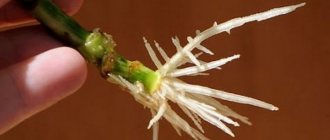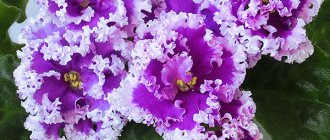Agricola is called the favorite drink of orchids. This is an effective means for feeding house plants, stimulating growth and development, increasing resistance to diseases and stress. The drug is easy to use and is harmless to humans.
However, this is a chemical composition, and orchids are sensitive to excess and deficiency of elements , excess of mineral salts. Therefore, errors in the use of the drug, at best, will not give the desired result, and at worst, will lead to loss of flowering, chemical burns, and plant death. Let's figure out how to properly use Agricola fertilizer.
Description and composition
Agricola is a balanced organic-mineral complex fertilizer , concentrate, produced by domestic producers.
Liquid fertilizer, dark in color, quickly soluble in water, odorless. It poses no danger to humans.
In addition to the main triad of macroelements (potassium, phosphorus, nitrogen), the preparation includes microelements in chelated form :
- boron;
- zinc;
- copper;
- iron;
- molybdenum;
- manganese.
Of particular value are organic humic acids and vitamin supplements - natural biologically active energy sources. By the way, they are the ones who give the fertilizer its earthy tint.
Interesting! Thanks to the presence of these components, Agricola is both a fertilizer and a biostimulant.
The proportional content of potassium, nitrogen and phosphorus is designed to maximally strengthen the orchid’s immunity and stimulate lush flowering. The proportion of nitrogen is lower than in other similar compositions , because the value of an orchid is in luxurious flowering, and not in lush greenery.
General information and methods
Using fertilizers to feed orchids is a necessary process for caring for them. The nutrients contained in the substrate are drawn out by the root system of the plants, and are also washed out with irrigation water through special drainage holes located in the planting container.
It is for these reasons that flowers grown at home require periodic feeding with mineral as well as various organic fertilizers. The instructions for performing not just good, but better feeding are extremely simple. As a rule, the composition to be used is one that has received a significant number of positive reviews. It is extremely important to fertilize your orchid correctly.
Forms of release of the drug
Agricola for orchids is available in the form of a gel concentrate and in granular form. The liquid mixes easily with water; it is convenient to measure the required amount using a graduated glass that comes with the container with the drug.
A bag of powdered water-soluble fertilizer can be purchased on the way to the dacha; it is compact and will not take up much space in your purse or pocket.
Agricola release forms.
Fertilizer reviews
Anastasia Serpakova (Terezya): I liked this fertilizer. I have four phalaenopsis, they grow in bark and polystyrene foam (in half), I fertilize them once a month in winter, 2 times a month in summer, immerse them for 20 minutes. They grow and bloom well. There is a peculiarity: I over-watered one of the phalaenopsis, there was a slight rotting (cured), but it had to be sprayed rather than watered by immersion, I diluted 5 ml per 2.5 liters of water, Agricola does not say anything about the norms, I played it safe. Therefore, I warn those who love by eye - if anything, try to take a smaller dose, not more, especially if the orha is gaining buds.
Irina Kriulina (Irisha79): It’s a good fertilizer in the sense that the orchids grow and bloom periodically, I haven’t noticed any difference with other fertilizers, I feed them according to the instructions. The inscription on the bottle made me laugh: “stimulates active plant growth, flowering, gives flowers a bright color” - for active growth and flowering, various fertilizers are needed, at the beginning of growth you need more nitrogen. Therefore, I recommend this fertilizer only for flowering; for the growth of green leaves, “Bona Forte for orchids” is better - it has NPK 6: 3: 7 - it is just better for leaves, but not for flowering. I liked Agricola in a measuring cup - it’s more convenient than pouring it into a cap, and besides, the fertilizer can be stored in the cold.
Lyudmila (lu-lu): I bought this fertilizer for phalaenopsis, but one liter of solution was too much for it, so I poured the liquid from it onto other flowers, and everyone was fine, the hibiscus bloomed like crazy. But for hibiscus I added half the dose of Agricola for flowering ones. I fed everyone once every two weeks (+/- 2 days).
iplants.ru: Agricola for orchids is a good fertilizer and is suitable for any plants besides orchids, but you need to feed the rest of the flowering ones more often - once every 5 days at the rate of 5 ml per 1 liter of water, which is not advisable - it is expensive. A bottle of fertilizer costs 65-75 rubles. As for orchids, as Irina Kriulina correctly noted, Bona Forte is more suitable for stimulating growth. In general, Agricola is no worse or better than other fertilizers for orchids, it is convenient to measure, the liquid is easily mixed with water. Note that the presence of humic acids is excellent for those orchids that grow with an open root or on an inert substrate (coconut shell or polystyrene foam). We recommend alternating this drug with other fertilizers for orchids, since in our opinion it is not balanced enough: there is no magnesium, sulfur, and the composition is not fully known.
Properties and effects
The verified, balanced composition of Agricola determined the properties of the fertilizer :
- mobilization of the body's immune mechanisms;
- increasing resistance to diseases of various origins, damage by fungi and bacteria, resistance to pests;
- reducing the waiting time for flowering, increasing its duration, intensity and effectiveness;
- increasing adaptability to unfavorable and changing external factors, stress resistance;
- stimulation of metabolic intracellular processes, which increases the vitality of the plant.
How to use?
The recommended procedure for using Agricola is indicated on the package. Before use, you must carefully study these instructions and follow them strictly.
To prepare a working solution from a liquid concentrate, take the drug at the rate of 5 ml per liter of water for root feeding, and half as much for foliar feeding.
Granular dry composition (25 grams per pack) is diluted in a bucket of water.
This pack is enough for a bucket of water.
Attention! Experts recommend further reducing the concentration of the drug in the following cases:
- feeding a young orchid;
- nutrition of a newly acquired plant in order to study and take into account its individual needs and characteristics.
Standard precautions:
- Prepare the solution while wearing gloves;
- do not allow the solution to come into contact with mucous membranes;
- Upon completion of work, wash your hands and face with warm water and soap.
Chemical composition and application
Water the orchid with fertilizer
Agricola is available in the form of a concentrated liquid solution, in granules or in the form of special sticks. The composition of the liquid form is as follows: nitrogen - 4%, phosphorus - 5%, potassium - 6%, sodium humate - 0.8%. In addition, it contains trace elements: boron, copper, zinc, manganese, iron and molybdenum.
The package contains 250 ml of fertilizer.
Instructions for use are simple. For root feeding, 5 ml of solution is diluted in 1 liter of water. For the convenience of preparing the working mixture, the bottle with the concentrated solution is equipped with a measuring cap. The process is repeated after 10-14 days, without increasing the rate of application of the nutrient substance.
When and what is it used for?
Agricola is a universal complex remedy. It is used in various situations:
- To better adapt the orchid to its new home conditions, but not earlier than a couple of weeks after purchase. Agricola reduces the impact of stress on the plant, shortens the period of adaptation;
- During the growing season , fertilizer stimulates energy processes, brings the start of flowering closer, increases its intensity and duration. The color of the flowers becomes noticeably richer and brighter;
- Agricola is an excellent remedy if the plant withers and develops poorly. The drug improves resistance to disease and triggers restoration processes in the orchid’s body. A distinctive feature of Agricola is the presence in its composition of humic acids - natural energy sources;
- immediately after transplanting an orchid; it is better to wait a few days. Fertilizing should begin after 1.5-2 weeks , then the fertilizer stimulates metabolic processes and the digestibility of nutrients, including water, air, light, and will contribute to the active growth of roots and leaves.
How does it affect the plant?
If the instructions and indications for use are strictly followed, Agricola for orchids has an extremely positive effect. Since the scope of application is quite wide, the effect will be on both the soil and the flowers. The drug is able to activate and improve plant growth , and also help cope with leaf drying.
One of the most important stages in the life of an orchid after purchase is adaptation to new conditions. Agricola, thanks to its rich composition, will greatly facilitate this stressful process for the plant. This fertilizer will help with a lack of minerals. We can even say that in some cases Agricola is a “lifeline” for orchids.
Rules of application for feeding
Agricola is intended for root and foliar feeding . To avoid mistakes and achieve the best effect, you must follow the recommendations for using the product.
Root
Fertilizer is applied during periods of active growing season , most often from late winter to mid-autumn. In winter, additional food is delivered to orchids once a month, during active months - every 7-10 days.
For root feeding, take five milliliters of concentrate per liter of water . The substrate and roots are pre-moistened with clean water, then watered with Agricola solution.
Agricola can be used for root feeding.
Foliar
For foliar feeding, prepare a less concentrated solution : take 5 ml per not one, but two liters of water. Processing can be carried out in the following ways:
- spray the plant with a spray bottle;
- wipe the leaves on both sides and aerial roots with a cotton swab dipped in Agricola solution.
Fertilizers delivered directly to the leaves are absorbed five times better. But this method should not be abused; foliar feeding is carried out no more often than once every two to three weeks.
Advice! If you are forced to apply foliar fertilizers while the orchid is blooming, make sure that the fertilizer does not get on the flowers.
Advantages of the drug
The fertilizer has a composition specially developed for plants of the phalaenopsis genus. The drug effectively protects the flower from fungal infections. The easy digestibility of the nutrient mixture promotes faster flower growth. Flowering begins earlier and lasts longer. Leaves and flowers acquire a brighter color.
This mineral complex ensures rapid restoration of the plant's vitality after the autumn-winter dormant period. It resists diseases much better and tolerates unfavorable environmental conditions.
The preparation is convenient to use, because it has a liquid consistency, most suitable for root and foliar feeding of orchids. They also note the safety and low price of the solution.
Precautionary measures
Orchids react very sensitively to chemical components contained in water, air, and fertilizing. Therefore, you should pay close attention to each element of care.
Water requirements
Tap or spring water may contain chemical compounds that are not beneficial for orchids, such as chlorine or zinc.
The best water is considered to be rainwater, melt water, and distilled water. Chlorinated water can be used, but it must first be left in an open container for at least a day.
Overdose: risks, consequences, methods of leveling
Overdose can occur due to:
- one-time use of a solution with an excess amount of Agricola;
- accumulation of fertilizer in the substrate and on the roots for a long time.
Overdose can lead to:
- to burns and death of roots;
- to a sharp reduction in the number of flowers or a complete refusal to bloom, in difficult cases - for several years;
- to growth retardation, developmental disorders;
- to excessive growth of green mass;
- to the growth of twisted, deformed leaves;
- to thickening, and then to cracking of the pseudobulbs.
Excess fertilizer can cause leaf deformation.
To reduce risks, it is recommended to take non-chlorinated water, preferably melt or rain water. In addition, it is more correct to use a slightly lower concentration of the feeding solution than indicated on the package , for example, not 5, but 2.5-3 ml per liter.
If an overdose does occur, the orchid should be removed from the pot, the roots should be washed with clean warm water, and the plant should be placed in a fresh substrate. Cancel any feeding for several months.
Types of Agricola for feeding
In addition to the main useful elements, each product includes a number of macro- and microelements. To obtain good results, determine what type of feeding to choose.
For indoor plants
For lovers of bright homemade greens, Agricola Aqua is suitable. It is possible to choose the appropriate preparation for different types of plants:
- for decorative: ideally maintains and enhances the splendor and brightness of the shades of leaves with multi-colored colors;
- for ficus: recommended for all types of crops;
- for palm trees: also used for dracaena, yucca;
- for cacti and succulents: a product specifically for these species;
- Fantasy - Agricola for indoor plants, a balanced complex.
The line includes fertilizer sticks for growing beautiful ornamental foliage plants and a similar option in the form of dry granules.
Proper use and adherence to instructions contributes to the rapid growth of green mass and the brightness of color accents on the leaves.
For vegetables
Since vegetable crops are very sensitive to the composition of the soil and its condition, the lack of nutrients is replenished with the help of fertilizers. This avoids developmental and growth disorders.
For vegetables use:
- Aqua Vegeta: increases productivity;
- Aqua Forward: stimulates seeds and bulbs, activates seedling growth;
- for berry crops: nutritional complex in granules.
There are several types of granular form: Agricola No. 1 - for cabbage, No. 2 - suitable for garlic and onions, No. 3 - for tomatoes, eggplants, peppers, No. 4 - intended for carrots, radishes and beets, No. 5 is used for zucchini, cucumbers, and No. 6 - fertilizing for seedlings.
Fertilizer reviews
Flower growers are surprisingly unanimous in their assessment of Agricola.
Andrey. “I feed my orchids only with Agricola. They bloom uncontrollably for 6-7 months. There are 2-4 flower stalks on each, all strewn with large bright flowers. Excellent fertilizer! It is convenient to measure, there is a special measuring cup. And on the bottle there is a recess for it, it’s convenient to store and won’t get lost. It is not advisable to water Agricola only during flowering: for some reason, my flowering time is reduced to 3 months. Therefore, I feed before the first flowers appear and after flowering.”
Marina. “Good fertilizer, high quality. But nothing outstanding. Just a good, reliable feed, but not a growth stimulant.”
Anna. “Agricola was a real lifesaver for my orchids in the first year! These were my first orchids, and I learned everything. Agricola was recommended. As I got “bored” and the plant got sick, I started spraying it. After two or three months, the orchid is healthy and throws out its flower stalks. Very pleased! Easy to use - follow the instructions. To avoid mistakes with the dosage, there is a glass with markings. The bottle is 250 ml, lasts a long time, the price is more than affordable.”
Natalia. “One orchid did not bloom for almost 3 years, for no apparent reason. Healthy leaves, strong succulent roots, and not blooming. A friend recommended trying Agricola. The substrate was watered and the leaves were sprayed for 2 or 3 months. Our beauty has bloomed! Thank you Agricola!”
Methods of fertilizing at home
Fertilizers are applied by root and foliar methods. Both methods affect the growth, development, and appearance of inflorescences. It is useful to alternate watering and spraying - the orchid “eats” well on leaves and roots. The flower needs fertilizer throughout the year. The exception is the rest period. At this time, the plant organism does not require additional stimulants.
Feeding schedule:
- with a high nitrogen content - introduced in the spring, during the growing season. Supports the plant at the start of development, growth, and starts the growth of leaf mass. Without this, the feeding area will be reduced and the flower will not survive. Complexes with equal NPK content (ratio of nitrogen, phosphorus, potassium) are also suitable;
- with a high potassium content - introduced during periods of stress, improves resistance to adverse factors and pest attacks (in summer). Provokes the growth of the root system, strengthens the immune system, ensures proper metabolism and photosynthesis;
- with a high phosphorus content - introduced in the fall, during the formation of buds and the appearance of inflorescences. Supports the formation of flower stalks and flower blooming. The nitrogen content should be minimal.
Tropical species, without a pronounced dormant period, growing with sufficient light, are fed even in winter.
Fertilizer frequency:
- In December-February at low temperatures, short daylight hours, in June-August at temperatures above 24°C - administered once a month.
- In autumn, spring - once every 2 weeks (if the flower is not at rest).
- Weak, small orchids are fed weekly. When they get stronger, grow, and gain strength, the feeding is reduced.
Features of foliar feeding
It is used on flowers with damaged root systems, when urgent delivery of nutrients is required. Spraying is effective for chlorosis, if the orchid suffers from a deficiency of microelements and during the period of active root growth (to avoid the risk of burns from solutions).
Foliar feeding is carried out on a cloudy day, or in the morning/evening. Drops of the solution should not be exposed to direct sunlight. The temperature in the room is 17-27°C, without drafts.
What to do:
- Spray the composition with a spray bottle on the upper and lower sides of the plates and visible areas of the root system. It should settle into a fine mist;
- do not spray buds and flowers;
- After irrigation, check the axils between the leaves and growing points. They must be dry;
- Fertilize once every 10-14 days during the growing season.
How to carry out root nutrition
Orchids receive food from the outside, so fertilizers are introduced not only into dry soil, but also into irrigation water. This way microelements are absorbed quickly and efficiently. Solutions are used in the active growth phase, when the first flower stalks appear until the first flowers open on healthy specimens. This will stimulate development and replenish the supply of plant proteins.
What to do:
- Carry out preliminary watering - the roots will absorb moisture and will not suffer from burns.
- Prepare soft or slightly acidified, settled or boiled water. Temperature is slightly above room temperature.
- Add balanced mineral fertilizer and prepare a solution.
- Place the pot in a container with fertilizer for 15-20 minutes. Hold the substrate to prevent it from falling out. Immerse slowly, pouring liquid over the top.
- After replenishing, the excess solution should flow out; empty the pan.
- Frequency of this procedure: 2-3 times a month in spring.
Peculiarity! You cannot fertilize sick orchids with root fertilizers; in this case, only foliar spraying is possible.
Is it possible to feed a blooming orchid with Agricola?
It has been noticed that the use of fertilizer at this time significantly reduces the lifespan of peduncles ; buds and flowers dry out and fall off.
Using Agricola during flowering may cause flowers and buds to fall off.
In cases where treatment cannot be avoided “for health reasons”, you should avoid getting the solution on flowers and buds and limit yourself to the minimum required amount of the drug.
Important! With the appearance of buds and throughout the flowering period, fertilizing should be discontinued.
When should it not be used?
Just like any drug, Agricol also has its own contraindications for use, that is, those cases when the use of this fertilizer is prohibited. Agricola is prohibited from being used in the following situations:
- The root system is burned by fertilizing, thereby causing harm.
- During the flowering period, the use of fertilizers is strictly prohibited, otherwise you can expect a decrease in flowering time. You will learn how and what to fertilize an orchid during flowering here.
- Do not fertilize during a pest attack or disease.
- After and during transplantation, fertilizing is prohibited.











